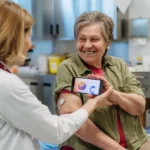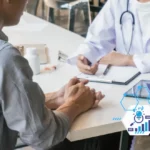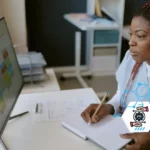RPM for Nursing Homes and Elderly Care Facilities

Elderly care is a delicate realm where nurses and physicians need to stay proactive to monitor any signs of ill health and bridge the gap between virtual care and in-clinic patient visits. In today’s steadfast healthcare scenario, Remote Patient Monitoring (RPM) for nursing homes and elderly care facilities plays a significant role in monitoring patients’ vitals from miles away without any need for in-person visits.
Whether a patient is dealing with a chronic health condition or healing after surgery, RPM empowers the care team to stay informed about the progress in the patients’ health journey. This consistent monitoring by healthcare professionals greatly reduces the occurrence of sudden complications and emergency room visits, especially in the elderly who are more prone to ill-health conditions.
Table of Contents
ToggleRPM Is the Key To Efficient & Consistent Care In Nursing Homes
Consistent monitoring via a robust patient monitoring platform empowers nursing homes to provide efficient care and successful health outcomes for chronic patients and the elderly. A successful RPM program collects and analyzes the patient’s physiological data remotely for establishing and managing treatment programs for chronic illnesses. In nursing homes and elderly care facilities, RPM provides tremendous benefits with access to better care outside of in-clinic settings, including:
- Improved Resource Management
One of the topmost advantages of RPM in nursing homes is improved resource management that allows the care team to simply receive and monitor patient-generated health data via remote patient monitoring software for healthcare providers. This is electronically transmitted to the platform for assessment by the nursing staff. Based on the results, the treatment plan and prescription are altered. Since patient monitoring is virtual, the costs associated with patient management are slightly reduced.
- Better Access To Care
Assess to better and easier care was one of the reasons why remote patient monitoring came into existence. Nursing homes can provide quality care to patients via digital health software that enables the care staff to closely monitor blood pressure, weight changes, heart rate, and activity level. This ensures the right care and support are administered to the patients when they need the most.
- Enhanced Care Efficiency
By implementing an RPM program into their care settings, nursing homes can greatly assist their chronic patients and seniors in improving their healthcare routines via a connected cellular device and RPM software. Remote monitoring allows nursing staff to provide better care to their patients, dealing with diabetes, hypertension, and other chronic conditions, which in turn prevents emergency room transfers. Not only this, it strengthens the communication bond between the patient and the nursing practitioner, resulting in enhanced engagement and outcomes.
- Timely Intervention
Just another benefit of a remote patient monitoring platform for nursing homes is delivering prompt medical advice and making timely intervention in a patient’s treatment plan. Emergencies can arise anytime, and transporting a patient to the hospital may seem a daunting process, especially if it’s night and the patient is located at a remote location. With RPM, a nursing practitioner can quickly respond in an emergency, provide real-time intervention, and address the ill-health condition before it worsens.
Importance of Remote Patient Monitoring (RPM) In Elderly Care Facilities
When it comes to maintaining good health and well-being in seniors, elderly care facilities implementing remote patient monitoring programs plays a crucial role. With aging, seniors confront a wide range of health issues, including chronic diseases, body pain, and age-related ailments. RPM represents a paradigm shift by allowing continuous monitoring and remote communication between healthcare professionals and seniors, thereby improving the care they receive. Some benefits of RPM in elderly care facilities include:
- Early Detection of Health Issues
RPM allows care providers to continuously monitor and track the vital signs and health data in seniors, thereby helping identify any ups and downs in health records. With proactive and timely monitoring via an RPM platform, any underlying health issues can be detected and treated at an early stage, thereby reducing the risk of health complications in the future, along with lowering hospitalization rates.
- Promotes Safety & Independence
Since a senior is under constant supervision by a care provider, RPM promotes a sense of safety and independence in the elderly, thereby providing them the reassurance of being able to manage their daily chores and movement on their own. Also, regular monitoring not only helps avoid accidents and promote general well-being but alerts a healthcare provider whenever an emergency arises.
- Personalized Care Plans
In the healthcare industry, it’s always a NO to one size fits all. Healthcare providers can create tailored care and treatment plans for each senior based on their vital readings using real-time health data uploaded on the RPM software. This personalized approach guarantees that interventions and therapies are tailored to the specific health requirements and medication preferences of an elder.
- Reduced Healthcare Costs
Remote Patient Monitoring has the capability to significantly lower the healthcare costs associated with elder care by reducing hospital readmissions, avoiding emergency room visits, and optimizing resource allocation. Not only this, but by helping identify health issues at an early stage, RPM helps save money on costly medical procedures.
- Improved Communication
RPM promotes highly engaging communication and involvement among healthcare practitioners, seniors, and their caregivers. This reduces the communication barrier that arises with remote care. Remote patient monitoring allows better care coordination, more prompt interventions, better outcomes, and higher engagement.
RPM: A Promising Technology In Nursing Homes & Elderly Care Facilities
Remote patient monitoring (RPM) has emerged as a remarkable approach for improving patient and senior care by allowing for continuous monitoring, early diagnosis of health issues, tailored care plans, and improving communication between healthcare providers and patients/ seniors. This healthcare technology can increase medication adherence, minimize emergency room visits and hospitalizations, and improve outcomes for chronic illnesses.
Healthcare providers must acknowledge the role remote patient monitoring plays in improving health outcomes, and quality of life in patients and seniors while keeping the healthcare expenses low at the same time.
HealthArc is a trusted remote patient monitoring company providing digital health solutions to healthcare providers, medical practitioners, clinicians, and physicians planning to improve care efficiency, patient engagement, and health outcomes. Our state-of-the-art technology is focused on paving the way for a successful remote patient monitoring program that helps your organization achieve its care objectives and goals.
Schedule a demo to learn how our platform works or call us today at +201 885 5571 to set up a consultation with our experts.
Frequently Asked Questions (FAQs)
RPM in nursing homes and elderly care settings uses connected devices and a digital health platform to continuously monitor residents’ vital signs and health data outside of traditional clinic visits. This enables care teams to stay informed, intervene early, and support seniors with chronic or post-acute conditions.
Because older adults often have multiple chronic conditions, mobility limitations, and high readmission risk, RPM offers improved access to consistent monitoring, reduced emergencies, and more efficient resource allocation in nursing homes and elder care.
- Improved resource management (staff can monitor many residents remotely)
- Better access to care (monitoring of vitals, such as blood pressure, weight, and heart rate)
- Enhanced care efficiency and timeliness of intervention (reducing hospitalizations)
RPM platforms capture and analyze physiological data over time (e.g., blood pressure trends, weight changes, heart rate fluctuations) and alert care staff when thresholds are exceeded, enabling earlier intervention and reducing the risk of complications or hospital admission.
Devices typically include blood pressure monitors, weight scales (for fluid/retention tracking), heart rate/oxygen saturation monitors, and potentially activity or mobility sensors. These data streams feed into the monitoring platform for trend analysis and alerts.
By providing continuous monitoring and timely intervention, RPM promotes safety and supports independence—residents can remain engaged in daily routines and avoid frequent disruptive hospital transfers, which enhances their sense of well-being.
RPM helps reduce hospital readmissions, emergency transfers, and high-cost interventions by enabling earlier intervention and better chronic care management in-facility. It also optimizes staff time by focusing on residents who need attention rather than blanket monitoring.
Facilities should look for ease of device deployment, connectivity reliability (especially in remote locations), intuitive user interfaces for staff/residents, strong alerting workflows, compatibility with existing care workflows, and secure data handling aligned with privacy regulations. (While the article emphasizes benefits rather than vendor-selection details, these are implied critical factors.)
Challenges may include resident adoption and training (some seniors may struggle with devices), connectivity issues (especially in older or rural facilities), integrating RPM workflows with existing care staff protocols, ensuring timely response to alerts, and aligning reimbursement or cost model for the facility. Though the article focuses on benefits, these are realistic implementation considerations.
RPM can complement in-facility nursing care, post-acute transitions, chronic disease programs, and care-coordination models by offering continuous data that augments episodic check-ins. In senior care settings, it supports proactive care instead of reactive care, which is in line with the goals of value-based care.
Yes—RPM is well-suited for post-acute monitoring in nursing homes and elderly care settings, where residents may require closer oversight following hospitalization. Continuous data allows care teams to detect complications early and support recovery workflows.
Critical. Success depends on training staff to use devices, interpret alerts, integrate workflows for escalation, and ensure residents are comfortable with the technology. Without proper workflow and buy-in, RPM benefits may not fully materialize.
Critical. Poor connectivity or complex devices reduce adoption, delay alerts, or cause data gaps—compromising the value of RPM. Facilities should choose devices with robust connectivity (e.g., cellular options) and minimal resident setup.
- Lower rates of hospital readmissions
- Transfers to the emergency room
- Medication adherence
- Staff response times to alerts
- Resident satisfaction/quality of life measures
- Cost savings per resident
- Device-data completeness/engagement rates
As with any healthcare-data solution, RPM platforms must comply with HIPAA and other relevant data-privacy regulations, ensure secure data transmission/storage, support role-based access, and align with facility-licensing or state long-term-care regulations. Despite being for elderly care, the underlying compliance requirements remain high.
Most Recent Blogs
Categories
Related Blog
- October 23, 2025 | Read Time: 12 mins
How RPM Devices Improve Hypertension and Diabetes Outcomes in Medicare Populations
Remote patient monitoring (RPM) is transforming chronic care for Medicare beneficiaries. CMS...
Learn More- August 25, 2025 | Read Time: 13 mins
How Can “One Big Beautiful Bill” Boost RPM Programs by $50B?
The “One Big Beautiful Bill,” signed July 4, 2025, directs $50B over...
Learn More- August 22, 2025 | Read Time: 17 mins
HealthArc Platform vs RPM Software Solutions
Is your healthcare organization trying to pick a remote patient monitoring solution?...
Learn More


